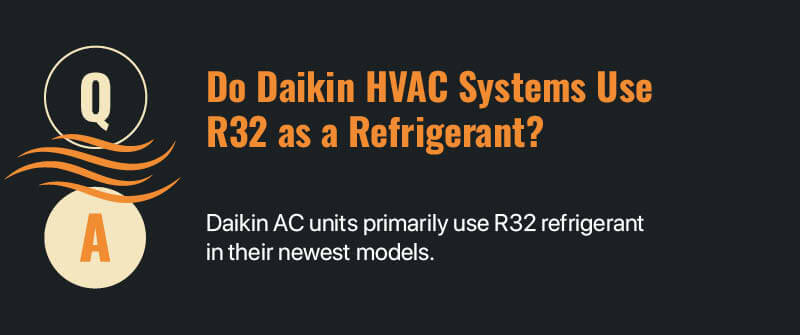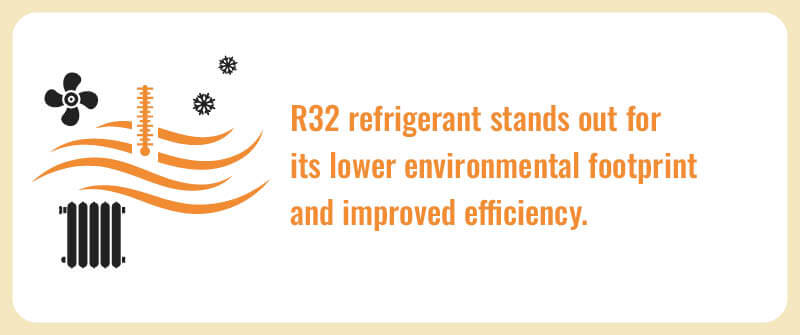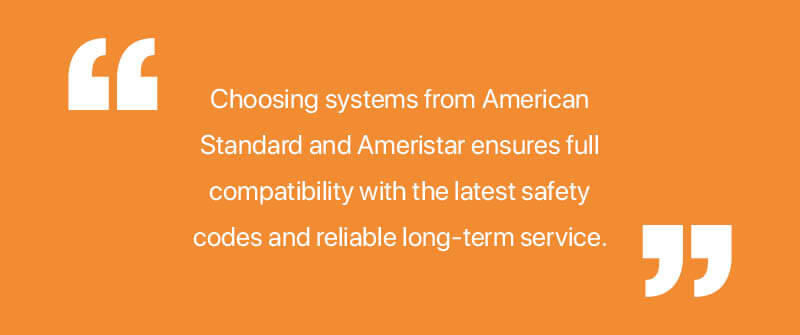Do Daikin HVAC Systems Use R32?
Is Daikin Using R32?
Daikin HVAC Systems has made significant strides in adopting R32 refrigerant for its air conditioners and mini-split systems, positioning itself as a leader in environmentally friendly HVAC technology. As of 2022 and continuing today, many Daikin models—including popular mini splits and ductless systems—use R32 to provide energy-efficient and eco-friendly comfort solutions for homeowners. This proactive shift not only reduces environmental impact but also ensures cutting-edge performance for Daikin customers.
For homeowners in Indianapolis and beyond, this means that choosing a Daikin R32 air conditioner brings an impressive blend of sustainability and efficiency. Compared to older refrigerants, R32 offers a lower Global Warming Potential (GWP), making it a far greener choice for your home. Daikin’s early adoption and broad deployment of R32 worldwide demonstrate their strong commitment to environmentally responsible HVAC solutions. The shift to R32 is part of a global movement, and Daikin was among the first major manufacturers to standardize R32 across numerous product ranges—offering homeowners advanced options long before some competitors caught up.
Do Daikin HVAC Systems Use R32 as a Refrigerant?
Daikin AC units primarily use R32 refrigerant in their newest models, especially in residential split systems and ductless mini split units. These systems typically consist of an outdoor unit connected to one or more indoor units, such as wall mounted units, to provide efficient climate control in homes. R32 is favored for its excellent energy efficiency, lower environmental impact, and ease of recycling compared to traditional refrigerants. R32 is a single component refrigerant, making it easier to recycle and service than blends. While Daikin once offered systems using R410A and other older refrigerants, the company’s current focus is on R32 for many markets due to its environmental advantages. The company introduced R32 in its product range to offer customers a new air conditioner option with advanced features and a smaller environmental footprint.
When selecting a Daikin AC, it’s essential to check the model’s documentation to confirm the refrigerant type. Daikin, as a leading manufacturer, offers a wide range of products designed for easy installation and maintenance, meeting the needs of both residential homes and discerning customers. If your top priorities include efficiency and keeping up with stricter environmental codes, a Daikin R32 air conditioner is an excellent and forward-thinking choice. Daikin’s equipment is known for its innovative features and reliable performance, making it a top choice among HVAC products.
Which Daikin Mini Splits Use R32 Refrigerant?
Many of Daikin’s mini split systems—especially the newer residential and light commercial offerings—feature R32 as the standard refrigerant. These mini split systems allow multiple indoor units to be connected to a single outdoor unit, providing flexible climate control for different rooms within homes. Notable series such as the Daikin FTKF, FTKM, and specific lines of ductless mini splits are powered by R32 and designed to be future-friendly, efficient, and reliable even in Indiana’s temperature swings. For homeowners looking for advanced climate control and eco-conscious technology, these Daikin models stand out for their performance and low environmental footprint. The range of features available includes easy operation via smart devices like a tablet, and the ability to customize comfort in individual rooms, making them ideal for modern homes.
Of course, while we at B&W Heating, Cooling, Plumbing and Electric recommend and install industry-leading systems, we specialize in American Standard and Ameristar brands, which currently utilize other high-performance refrigerants. If you’re weighing the benefits of Daikin’s R32 systems versus trusted brands like American Standard or Ameristar, feel free to reach out to our friendly team for personalized advice. We are committed to helping you find the perfect fit for your Indianapolis home—with outstanding comfort, safety, and long-term peace of mind. Daikin’s mini split systems are designed to meet the needs of a wide variety of customers, offering reliable comfort for all types of homes.
R32 Refrigerant Details: Safety, Regulation, and Phase-Out
Understanding the R32 refrigerant is essential for homeowners considering modern HVAC systems or curious about future trends in air conditioning technology. R32 is recognized for its superior cooling efficiency, lower environmental impact compared to older refrigerants. This smaller impact is due to R32’s lower GWP and improved efficiency. R32 is also compatible with a wide range of HVAC equipment, including modern heat pumps, making it a versatile choice for both cooling and heating applications. However, there are important questions regarding its safety, regulatory approval, and long-term viability that every homeowner should know before making a decision.
Note: GWP values and safety standards referenced here are based on current industry guidelines and may be subject to change as new research emerges.
Is R32 Refrigerant Banned?
The short answer is that R32 refrigerant isn’t universally banned, but some regions or building codes have restrictions due to its classification as a mildly flammable gas. Regulatory agencies like the EPA and international bodies are focused on balancing R32’s environmental benefits—such as its lower Global Warming Potential (GWP)—against concerns around safe transportation, storage, and installation in certain settings. In most of the U.S., including Indiana, R32 is not banned in residential applications, but it’s always best to work with a certified expert like the team at B&W Heating, Cooling, Plumbing and Electric to ensure your system meets all applicable codes and safety standards.
Is R32 Flammable?
Yes, R32 is mildly flammable. It is rated as an A2L refrigerant according to the ASHRAE safety classification. This means it has low toxicity but is capable of burning under certain conditions. Extensive safety standards are in place governing the use of R32 in HVAC systems, requiring proper installation, electrical controls, and ventilation to minimize any possible risk. For homeowners, the key takeaway is that, when installed and serviced by a licensed professional, R32 systems are designed to be safe in your home. At B&W, all of our technicians are thoroughly trained on refrigerant safety (though we primarily install American Standard and Ameristar systems, which use different approved refrigerants in the U.S. market).
What Is the Phase-Out Status of R32?
The future of R32 refrigerant is tied closely to worldwide efforts to minimize the environmental impact of HVAC systems. Unlike some older refrigerants such as R22 and R410A, R32 has a much lower GWP, making it a more environmentally friendly option. Currently, R32 is considered a next-generation refrigerant and is not subject to imminent phase-out like previous high-GWP options. However, regulatory agencies are consistently evaluating refrigerants based on safety, environmental impact, and efficiency. Homeowners can expect R32 to remain in use for years to come, but eventually, even lower-GWP alternatives (like R454B) may become more common. Choosing a reputable installer is crucial to ensure your new system complies with current and future standards.
How Does R32 Compare to Older Refrigerants?
Compared to older refrigerants like R22 and R410A, R32 stands out for its lower environmental footprint and improved efficiency. With a GWP of 675, R32 has just about one-third the GWP of R410A, meaning it contributes less to global warming if released into the atmosphere. R32 systems are also typically more energy efficient, leading to lower energy bills. While the mild flammability of R32 does require extra care during installation, these safety measures are well-understood in the HVAC industry. For Indiana homeowners, systems using newer refrigerants like R32 (or the American Standard and Ameristar options available through B&W) present a smart way to future-proof your investment while being mindful of environmental impacts and regulatory changes.
Daikin R32 vs. R410A: What’s the Difference?
Understanding the differences between Daikin R32 and R410A refrigerants is crucial for homeowners considering a new air conditioning or HVAC system. Put simply, R32 is a next-generation refrigerant designed to offer higher efficiency, a lower environmental impact, and improved performance compared to its predecessor, R410A. R32’s smaller impact on the environment, due to its lower global warming potential and reduced CO2 emissions, is a key reason for its adoption in modern systems. Both R32 and R410A are commonly found in modern air conditioners. R32 is also widely used in heat pumps, further expanding its role in energy-efficient climate control through advanced heat pump technology suitable for both mild and cold climates. The benefits, safety considerations, and long-term sustainability of each can differ significantly.
Performance and Efficiency
When comparing performance and efficiency, R32 comes out ahead. R32 refrigerant has a greater ability to transfer heat, making it more effective at cooling or heating your home. This enhanced efficiency often translates to lower energy bills and reduced strain on your HVAC system. Additionally, Daikin has engineered many of its R32 air conditioners with advanced compressors that are fine-tuned to maximize the refrigerant’s performance, ensuring reliable comfort during the harshest Indiana winters or hottest summer days. R410A, while still efficient, doesn’t match the superior thermal properties of R32, which is why more brands—including Daikin—are making the switch in new models.
Environmental Impact
The environmental impact of refrigerants is measured by Global Warming Potential (GWP) and Ozone Depletion Potential (ODP). Here, R32 is a clear winner: it has a GWP of 675, which is about one-third lower than R410A’s GWP of 2,088. Neither refrigerant depletes the ozone layer, but because of the much lower GWP, R32 aligns better with global efforts to reduce the environmental effects of home cooling and heating. This is why regulatory changes are pushing manufacturers to use more climate-friendly options like R32 or other upcoming refrigerants.
Cooling and Heating Capacity Differences
For homeowners, it’s also important to think about how refrigerants affect cooling and heating capacity. R32’s superior heat transfer properties mean Daikin units using R32 can often deliver more consistent and powerful climate control than similar R410A models. This is particularly noticeable in regions with temperature extremes, like here in Indianapolis, where reliable year-round performance is vital for comfort and safety.
Comparison With Upcoming Alternatives Like R454B
Looking ahead, new alternatives like R454B are starting to enter the HVAC market, offering even lower GWP ratings than R32. However, many of these newer options are still being tested for widespread residential use. For now, R32 strikes a favorable balance between performance, safety, and environmental responsibility—making it a smart choice for most applications. Daikin and other industry leaders are keeping an eye on the regulatory horizon and will continue to adapt as technology develops.
Suitability for Residential vs. Commercial Use
R32 is particularly well suited for residential HVAC systems due to its efficiency, safety (with proper installation and use), and reduced impact on the environment. For many homeowners, upgrading to a Daikin R32 air conditioner means investing in a future-ready system that meets current and upcoming standards. For large commercial buildings, refrigerant selection may depend on unique system requirements, building size, and local codes—but R32 is steadily gaining ground in both segments thanks to its versatility and superior attributes. Businesses benefit from the widespread availability of R32, produced by multiple manufacturers, and its regulatory compliance, making it a practical choice for many business applications.
For homeowners in Central Indiana, B&W Heating, Cooling, Plumbing and Electric recommends HVAC solutions that combine efficiency, safety, and reliability. While Daikin’s R32 systems offer compelling advantages, we proudly install American Standard and Ameristar systems that also lead in performance and environmental responsibility. If you’re considering an upgrade, our expert team can help you compare options and choose the right system for your home’s unique needs and future energy savings.
Choosing the Right HVAC System: R32 and Beyond
When considering a new HVAC system, the type of refrigerant used can be as important as the brand itself—especially if you’re interested in energy efficiency, environmental impact, and compliance with future regulations. Many leading brands, including Daikin, have embraced R32 air conditioner technology for its lower environmental footprint and high performance. But American Standard and Ameristar – brands proudly installed by B&W Heating, Cooling, Plumbing and Electric – remain industry benchmarks in reliability and future-forward design, focusing on safety, proven technology, and customer trust.
Which Mini Splits Use R32 Refrigerant?
Several major HVAC manufacturers have adopted R32 refrigerant in their mini-split and ductless models, leveraging its impressive efficiency and reduced global warming potential (GWP). Daikin is often recognized as a global pioneer, with most of its recent mini-split and ductless offerings running on R32. Other international brands, such as Mitsubishi and Fujitsu, have also rolled out select R32-compatible systems for global markets. However, in the United States and particularly in Indiana, American Standard and Ameristar systems—both available through B&W—tend to use the industry-standard R410A, emphasizing safety, long-term availability, and dependable performance.
Should Indiana Homeowners Choose R32 or Stick With Proven Alternatives?
For Indiana homeowners, choosing between an R32 air conditioner and established alternatives like R410A is about more than just initial efficiency ratings—it’s also about local support, federal and state regulations, and peace of mind. While R32 is celebrated for its lower GWP and strong energy ratings, it is also mildly flammable and subject to evolving regulatory standards in the US. Choosing systems from American Standard and Ameristar ensures full compatibility with the latest safety codes and reliable long-term service, with no worries about refrigerant phase-out timing for the foreseeable future.
What About Environmental and Regulatory Concerns?
Future-proofing your HVAC investment means paying close attention to environmental stewardship and emerging regulations. R32 is a step forward from older refrigerants, but the HVAC landscape continues to evolve, and not all refrigerants are legal or widely adopted in every state. With brands like American Standard and Ameristar, Indiana homeowners benefit from proven reliability and well-supported maintenance infrastructure, while the brands themselves stay at the forefront of regulatory changes—ensuring any transition to new refrigerants will be smooth and fully supported by expert technicians.
Trust B&W Heating, Cooling, Plumbing and Electric to simplify your HVAC decisions! As Central Indiana’s family-owned experts since 1961, we offer only the highest quality American Standard and Ameristar systems—balancing trusted technology, fair and transparent pricing, and fast service with no hidden fees. Contact B&W and let our team help you choose the safest, most efficient HVAC system for your home’s comfort and future peace of mind.




